Many talented South American footballers leave their native countries to try and make a name for themselves in Europe. One of the countries that produces the most talented South American footballers is Colombia, with many of their internationals playing for big clubs in Europe. Examples include Luis Díaz at Liverpool and Davinson Sanchez at Tottenham. One name that goes under the radar is 22-year old Feyenoord winger Luis Sinisterra.
Sinisterra joined Feyenoord in the summer of 2018 from Colombian side Once Caldas for a fee of around €2 million. He did not hit the ground running in Rotterdam, but has gotten better season-on-season, with the 2021/22 campaign currently looking like his breakout season. This tactical analysis and scout report will take a look at a few of Sinisterra’s strengths, with it looking likely he will be moving on to a big European club in this upcoming summer transfer window.
Positioning overview
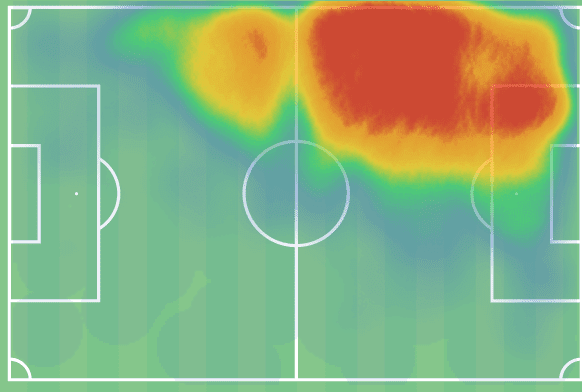
Under former AZ Alkmaar boss Arne Slot’s tactics, Feyenoord have been deployed in a 4-2-3-1 formation this season, with Sinisterra starting as the left attacking midfielder. As Sinisterra’s heat map from this season shows, he likes to drift wide left and play as almost a left-winger. In this wider position, he is able to use his quick acceleration as well as dribbling ability to beat opposition fullbacks 1v1. He also tends to cut inside on his favoured right foot, with Sinisterra being deployed as an inverted winger in Slot’s 4-2-3-1 formation.
Dribbling
One attribute that Luis Sinisterra excels at is his dribbling ability. When delving deeper into his dribbling statistics, you will come across that this season for Feyenoord in all competitions, Sinisterra has 7.57 dribbles per 90. This number goes along with an above-average success rate of 64%. With Sinisterra operating more as an inverted winger from his left attacking midfield position when the match gets going, this allows him ample opportunities to run at people 1v1 with the ball at his feet; and as a result, demonstrate his above-average dribbling capabilities. He also has demonstrated the ability to utilise his dribbling to take defenders on in 2v1 situations, with these normally occurring on the edge of the opponents’ penalty area.
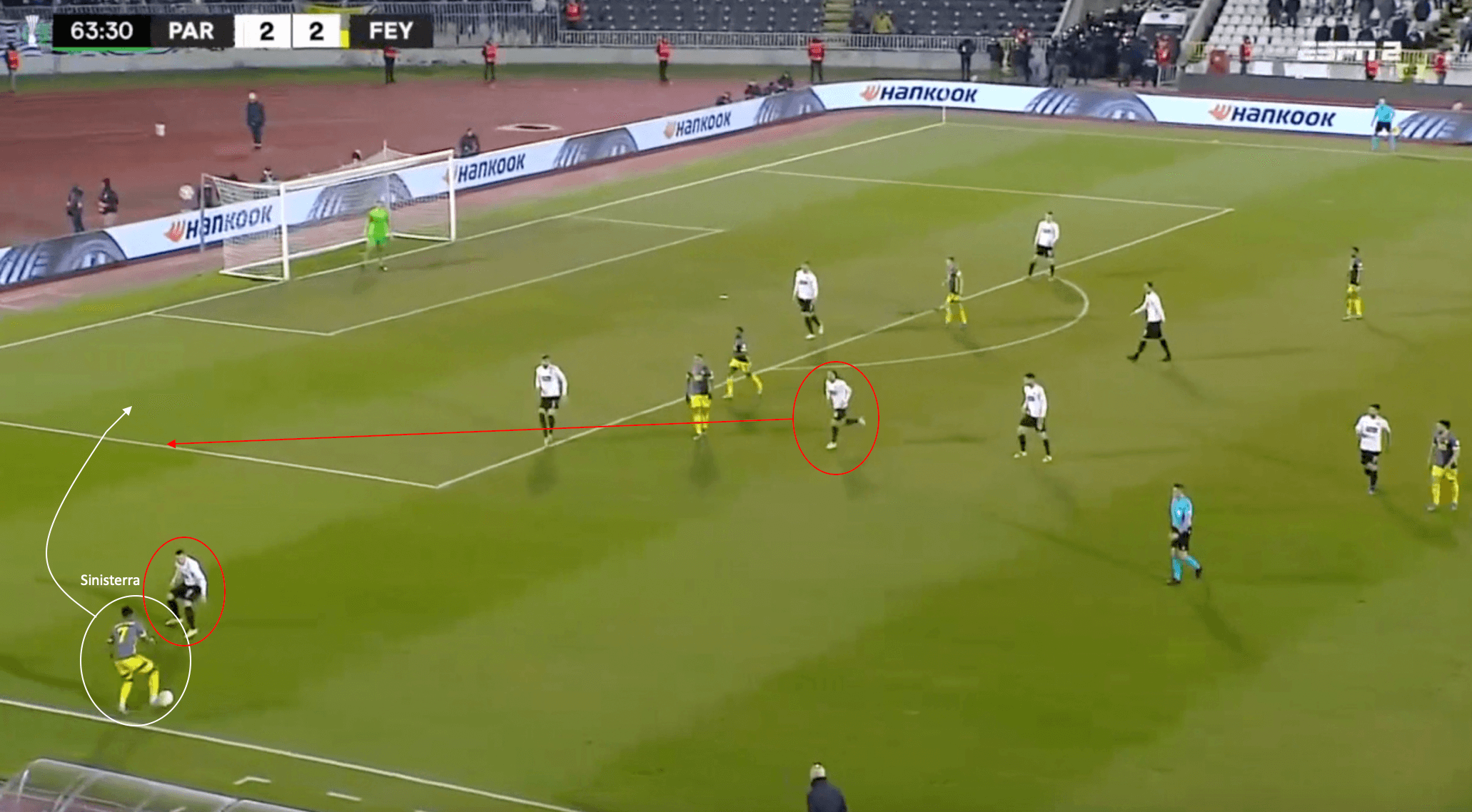
The phase of play above from Feyenoord’s Europa Conference League match against Partizan shows a good example of what Sinisterra is capable of when he is able to dribble from this wide left position. He is isolated 1v1 against the fullback and goes by him after a couple of stepovers. The fullback tracks him to the edge of the box and is helped by the central midfielder who drops back. This allows Sinisterra to demonstrate his ability in 2v1 situations, and after a couple of tricks, is able to get past both and send a ball across goal. Unfortunately, no Feyenoord player is on the end of the ball; but it does show the ability that Sinisterra has to create a goal-scoring opportunity out of nothing with his dribbling.
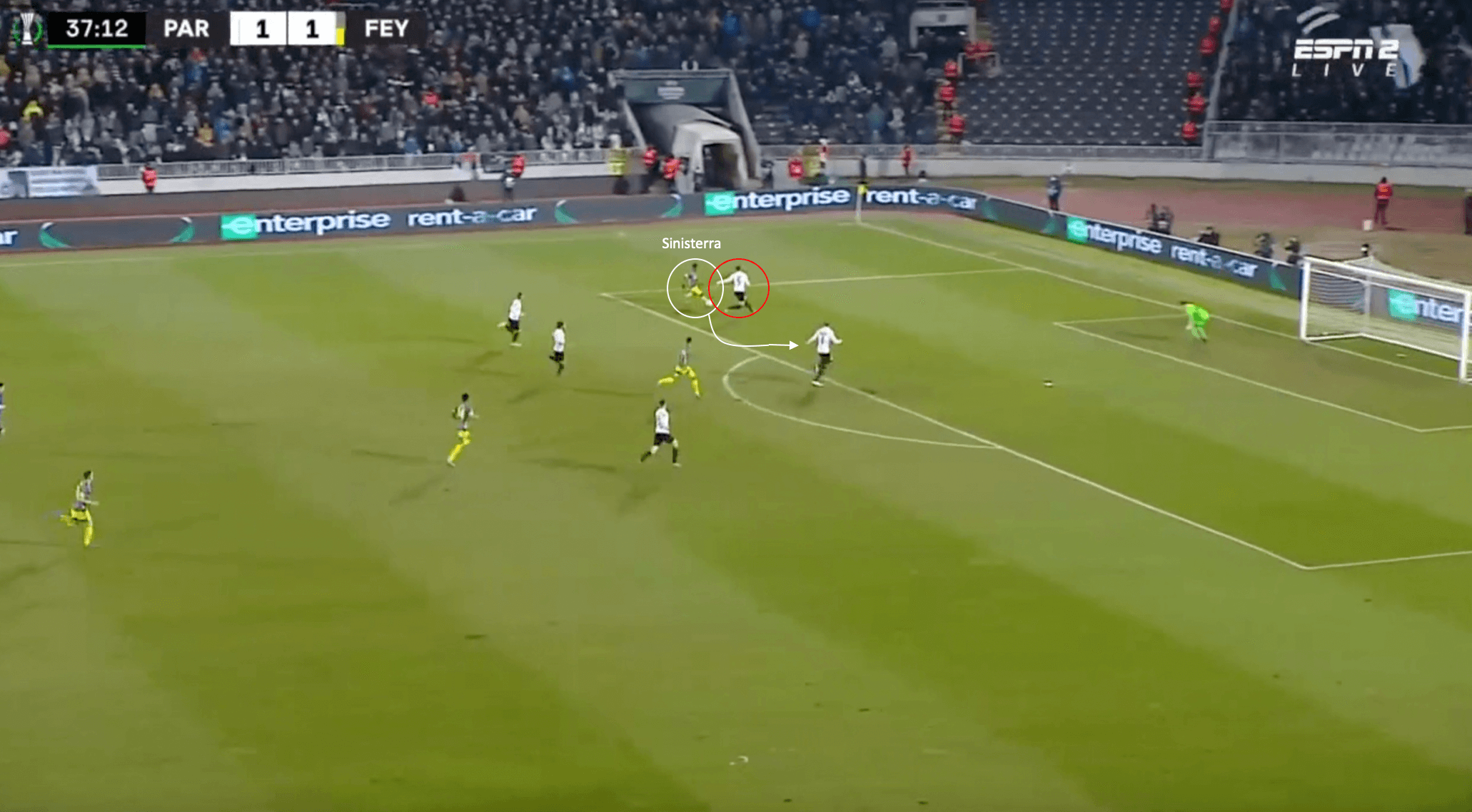
This example from the same match demonstrates Sinisterra’s close control in attacking areas. In the phase of play above, Sinisterra is driving into the box and is isolated 1v1 against the Partizan defender. He is able to use his close control and great footwork to dribble the ball past the defender, leaving him on the ground in the process. Unfortunately, the ensuing shot by Sinisterra is blocked by the Partizan defender tracking back. Though he did not score, this solo mazy run by Sinisterra once again demonstrates his capabilities when the ball is at his feet.
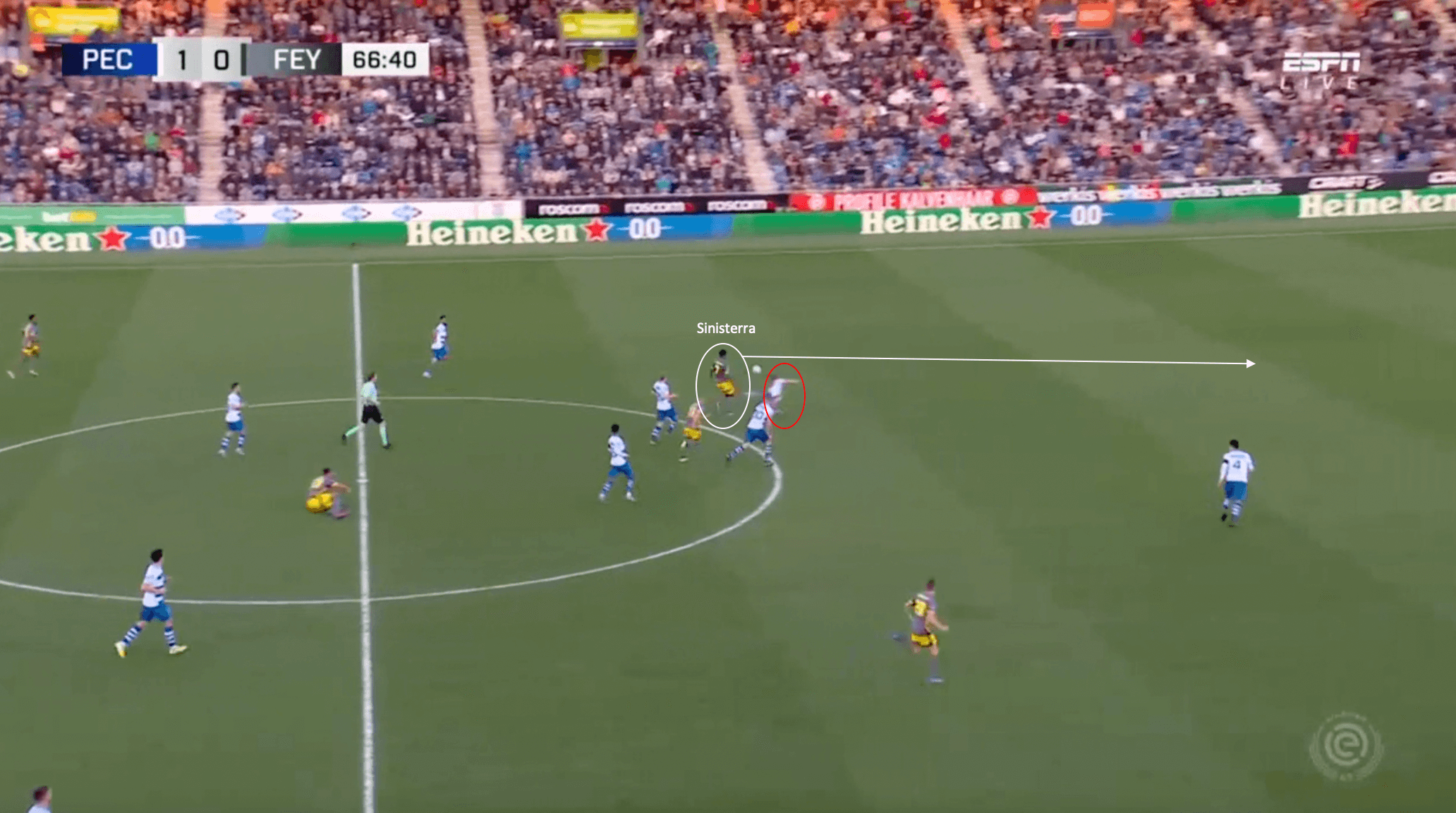
Sinisterra is also able to utilise his dribbling in more central areas of the pitch as well, with the phase of play against PEC Zwolle above a good example. Sinisterra collects the ball in this deeper central area, and is able to flick the ball over the diving defender, before jumping over him and running onto the ball into the open space ahead. He is then able to drive into the 18-yard box before cutting inside and shooting past the goalkeeper, via a deflection. What this example shows is that while Sinisterra prefers to utilise his dribbling in wider areas; he will also attempt to take players on in central areas as well, and while the reward may not always be worth the risk, Sinisterra has the dribbling ability to create something special.
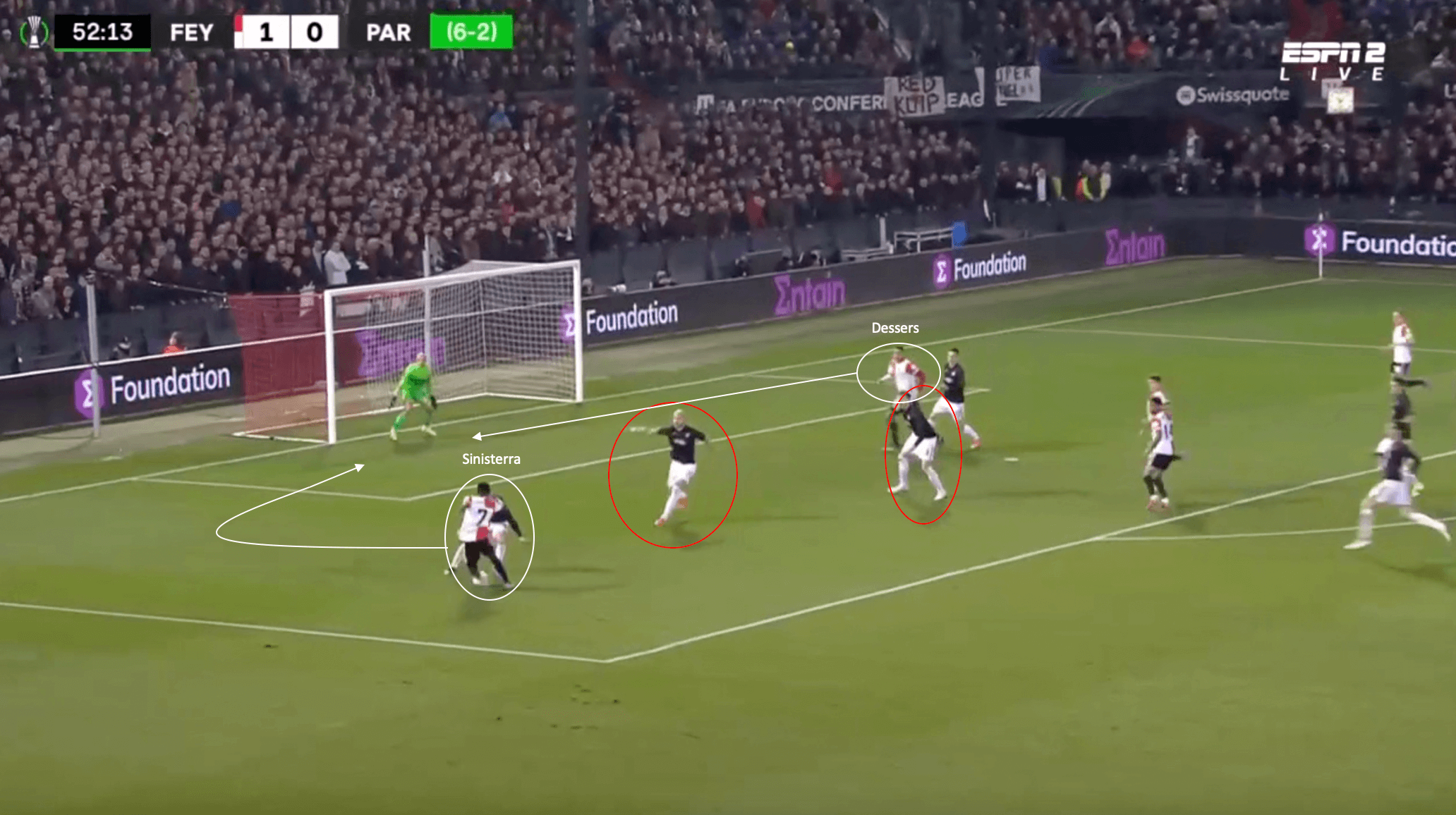
This final example shows the attention that Sinisterra attracts from his dribbling in the 18-yard box. Sinisterra is able to do a couple of stepovers, which allows him to get past the fullback in a 1v1 situation. This dribbling attracts the attention of the two other Partizan players, circled in red. This allows Cyriel Dessers to make an unmarked run towards the centre of the goal. Once Sinisterra is able to dribble past his marker, he plays a well-weighted pass into the vacant space that Dessers is running into. Unfortunately, Dessers sends his shot just wide of the near post.
This section has been able to showcase the dribbling ability of Luis Sinisterra. Playing in this wide attacking midfield position for Feyenoord supports his dribbling well; as Slot’s system allows him to become more of a free-roaming inverted winger. This allows him to more often showcase his spectacular dribbling ability.
Passing
Another strength in Sinisterra’s game is his range of passing, as well as accuracy. Playing as the left attacking midfielder for Feyenoord, Sinisterra is averaging 39.8 passes per 90, with a success rate of 85.2%. He is very selective in his passing, and rarely attempts anything spectacular. When you break this passing down further and look at Sinisterra’s passes to the final third, passes to the penalty area, and forward passes, in per 90 and success rate percentages, the passing numbers are still quite good: 2.83, 79.8%; 2.42, 66.3%; and 6.62, 73.3%, respectively. This section will take a look at some examples of Sinisterra’s passing.
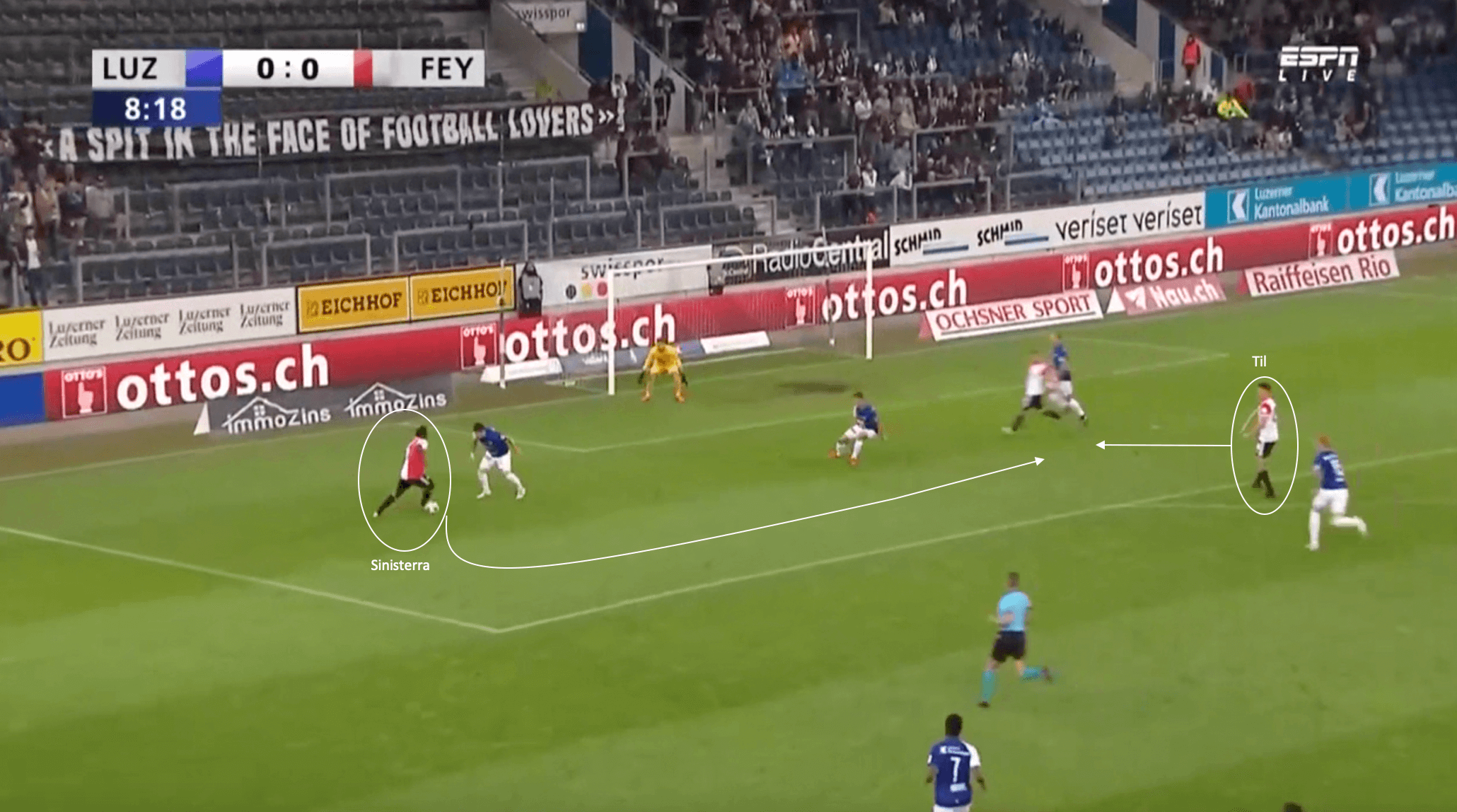
The phase of play above from Feyenoord’s European qualifying match against FC Luzern shows Sinisterra’s ability to use his vision and passing accuracy to find a teammate free in an advanced area. In this situation. Sinisterra is trying to find the space to curl a shot in himself. However, he notices that Guus Til has found himself unmarked near the penalty spot. He is able to play a pass to Til, who takes a touch and fires his shot past the goalkeeper. Though Sinisterra probably would have liked to shoot himself, in this scenario, he was able to use his vision and range of passing to find his teammate in a better shooting position.
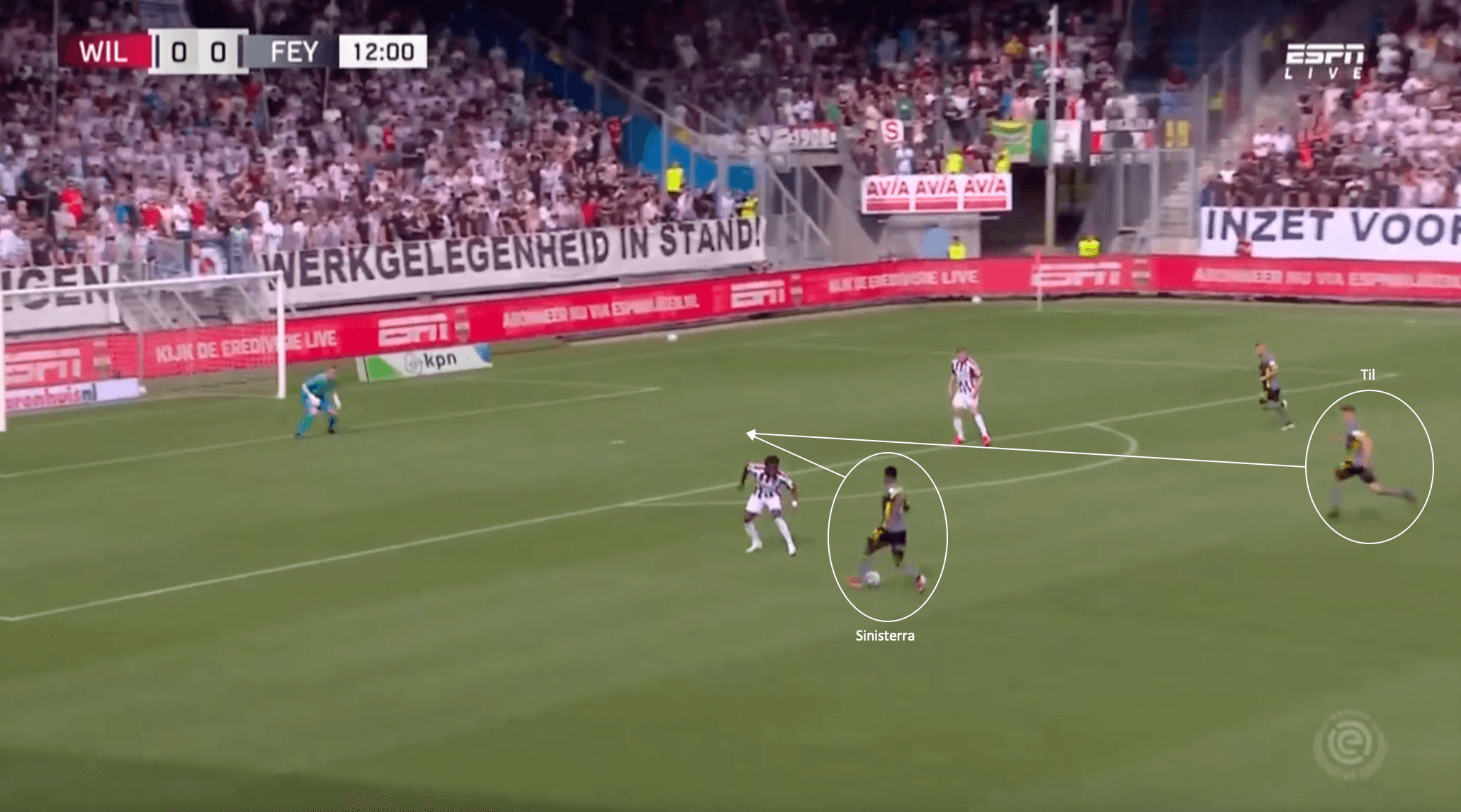
The phase of play above shows another good example of Sinisterra’s ability to recognise teammates moving into better attacking positions, and playing great passes to them as a result. In this attacking sequence against Willem II, Sinisterra could have easily attempted to take on the defender to try and get past him and take a shot on goal. However, he recognises the run from deep that Guus Til is making, so he slows down his run to let Til and the other attackers catch up. Sinisterra then cuts inside before playing a perfectly weighted through ball into the path of Til. Unfortunately, Til’s ensuing shot is blocked by the defender.
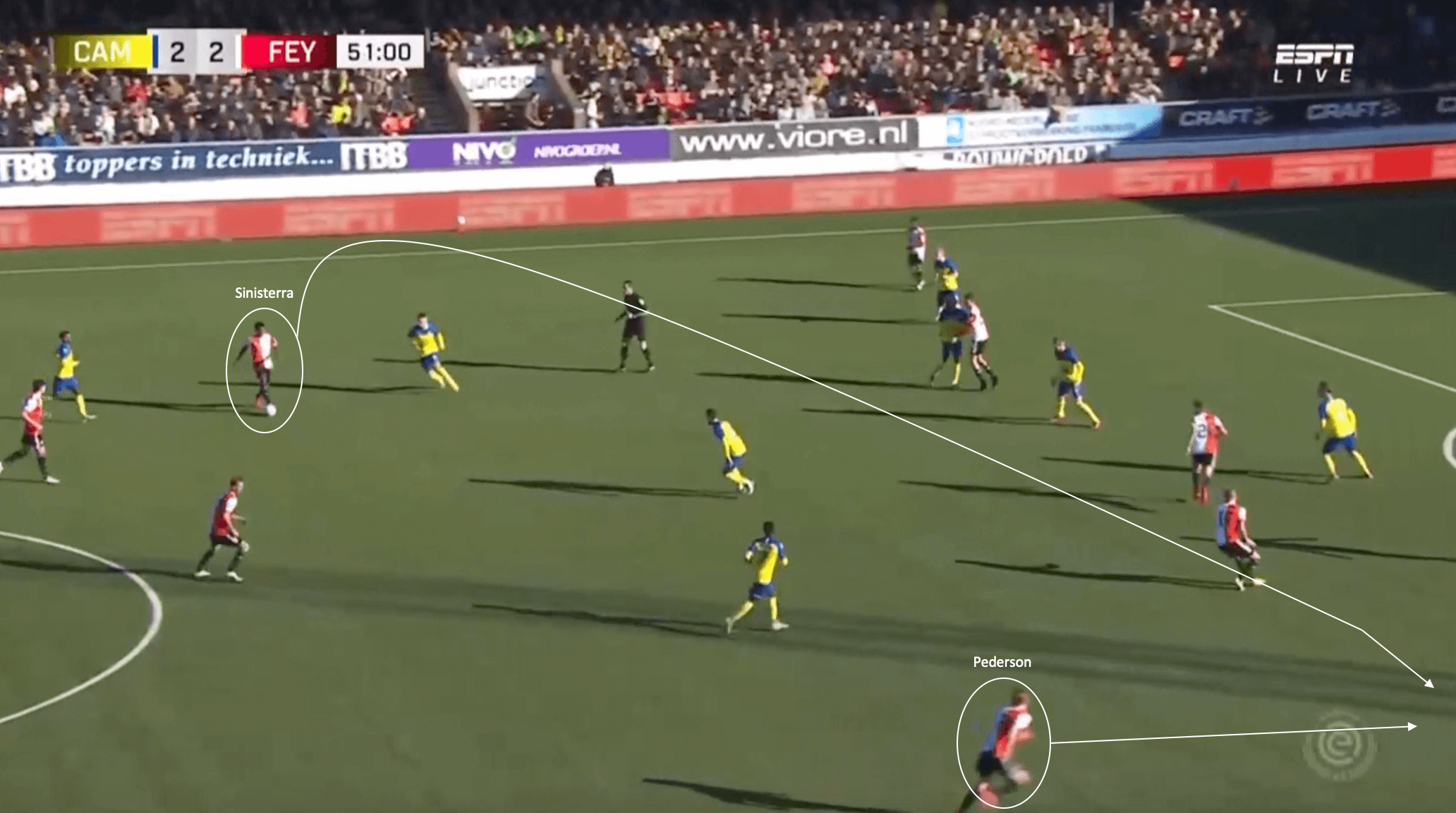
It is not just from near the penalty area where Sinisterra’s passing range is on full display. In the phase of play above against SC Cambuur, Sinisterra is in possession of the ball in a more central position. He is able to spot the run of fullback Marcus Pederson and play a perfect ball over the top to catch Pederson in stride. Unfortunately, Pederson is dispossessed when he reaches the byline, and a goal kick is awarded. Though no goal-scoring opportunity came about from this great ball over the top from Sinisterra, it does show his capabilities when it comes to more long-distance passing.
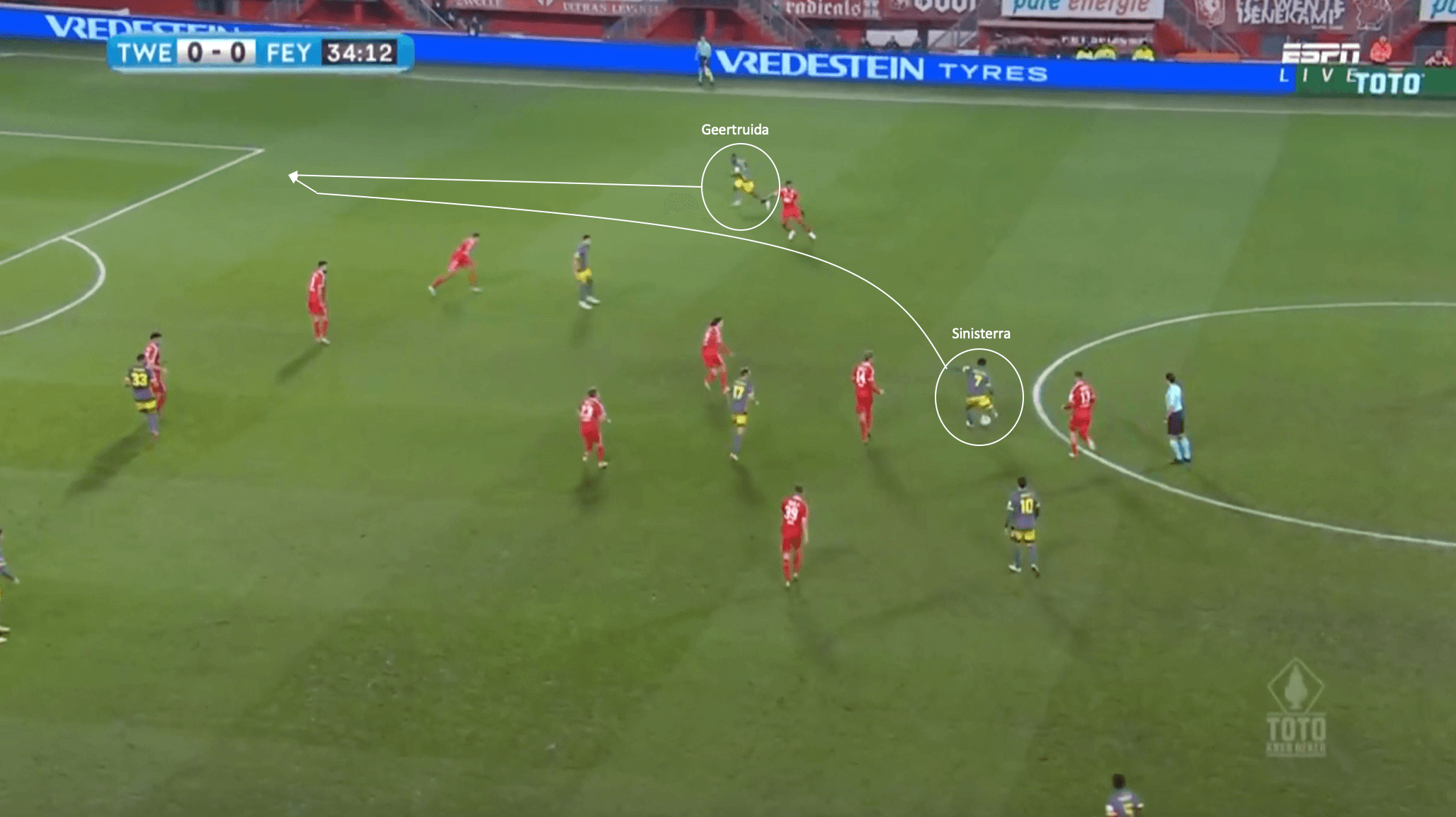
The final example for this section once again looks at the quality of passing that Sinisterra is able to demonstrate from a more central position. In this sequence of play against FC Twente, Lutsharel Geertruida makes a great run behind the Twente defence, which Sinisterra is able to spot. He once again plays a perfect ball over the top to catch Geertruida in stride. Unfortunately, the ensuing run into the penalty box and shot is saved by the goalkeeper.
This section has been able to show that while Luis Sinisterra plays more like an inverted winger most of the time in this Feyenoord team; he does demonstrate the vision and passing range that is more akin to that of a central midfielder.
Finishing ability
Across all competitions for Feyenoord this season, Luis Sinisterra has scored 18 goals, second highest in the Feyenoord squad. He only trails Guus Til who has 20 goals in all competitions for the Rotterdam side this season. Though primarily right-footed, Sinisterra also has the capability to score with his left foot as well, with 6 of those 18 being scored with his left. This tally also includes three headed goals as well. Most of Sinisterra’s goals are also very similar, with him cutting inside from his inverted winger position and getting a shot off with his favoured right foot.
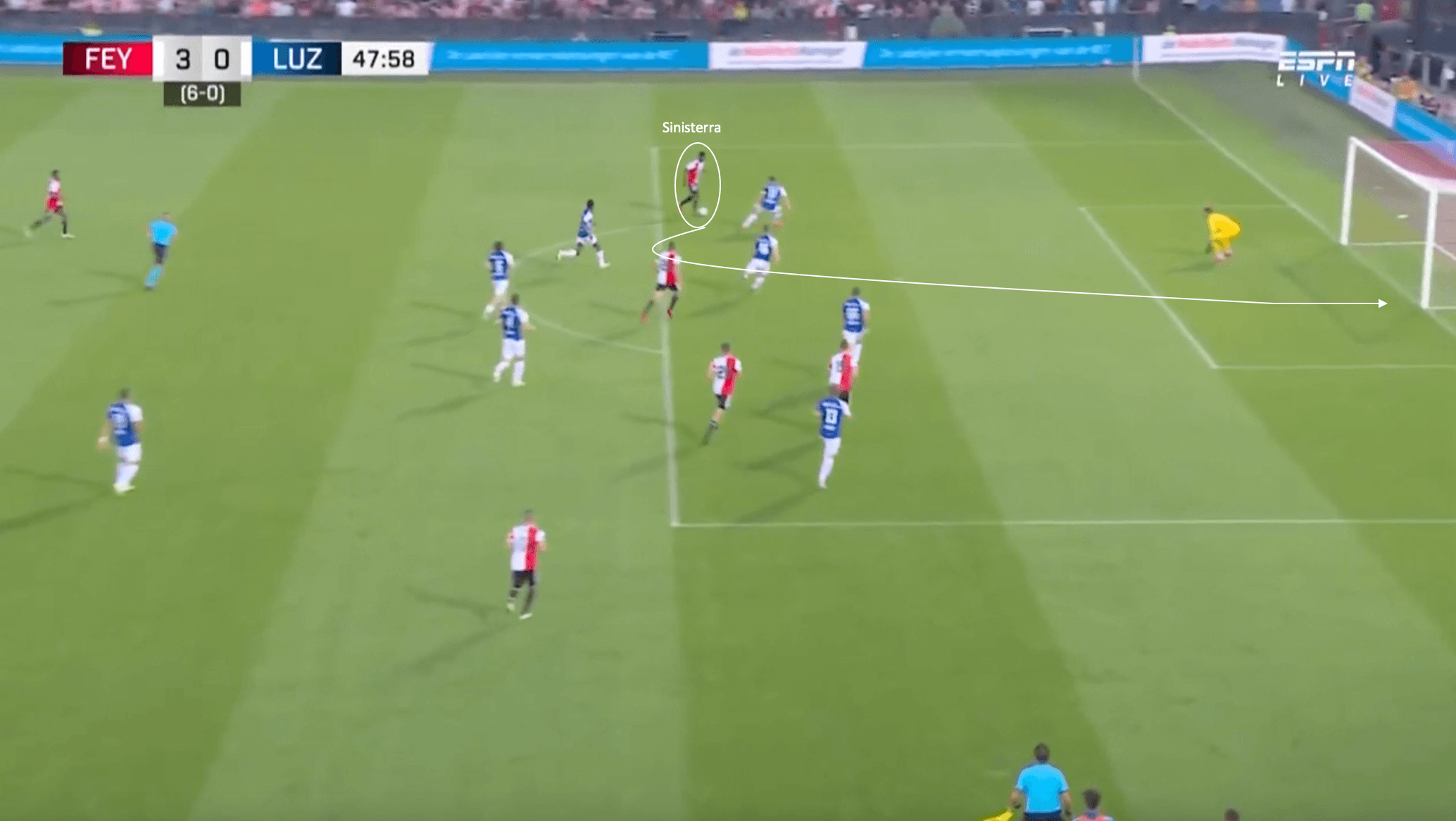
This goal scored by Sinisterra against FC Luzern is a perfect example of his finishing. He drives into the opponent’s 18-yard box and is able to get the opposition defender off balance with his dribbling. This allows the space to open up, which lets Sinisterra cut inside and fire a shot with his right foot past the goalkeeper’s far post. Though not the most spectacular finish, it is trademark for Luis Sinisterra.
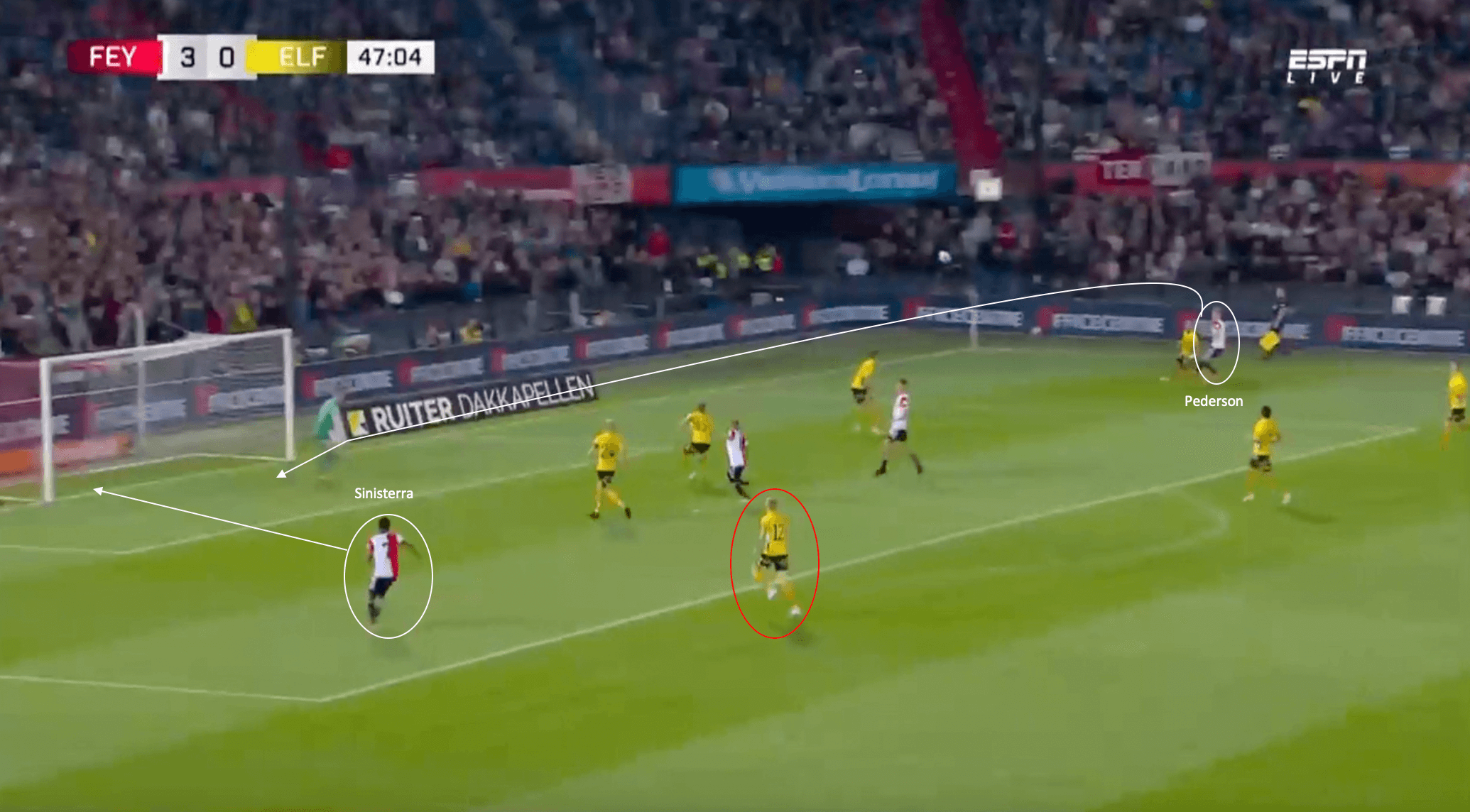
As mentioned earlier, it is not only with his favoured right foot that Luis Sinisterra is able to convert chances with. In the attacking phase of play above against Elfsborg, Sinisterra has found himself away from his marker and free as a crossing option at the back post. Marcus Pederson is able to spot Sinisterra’s run and proceeds to play a perfect cross into his path. Realising that he would not have the time to take a touch to bring it down and get a shot off with his favoured right foot; Sinisterra opts to go with his head and fires a bullet header past the goalkeeper at the far post.
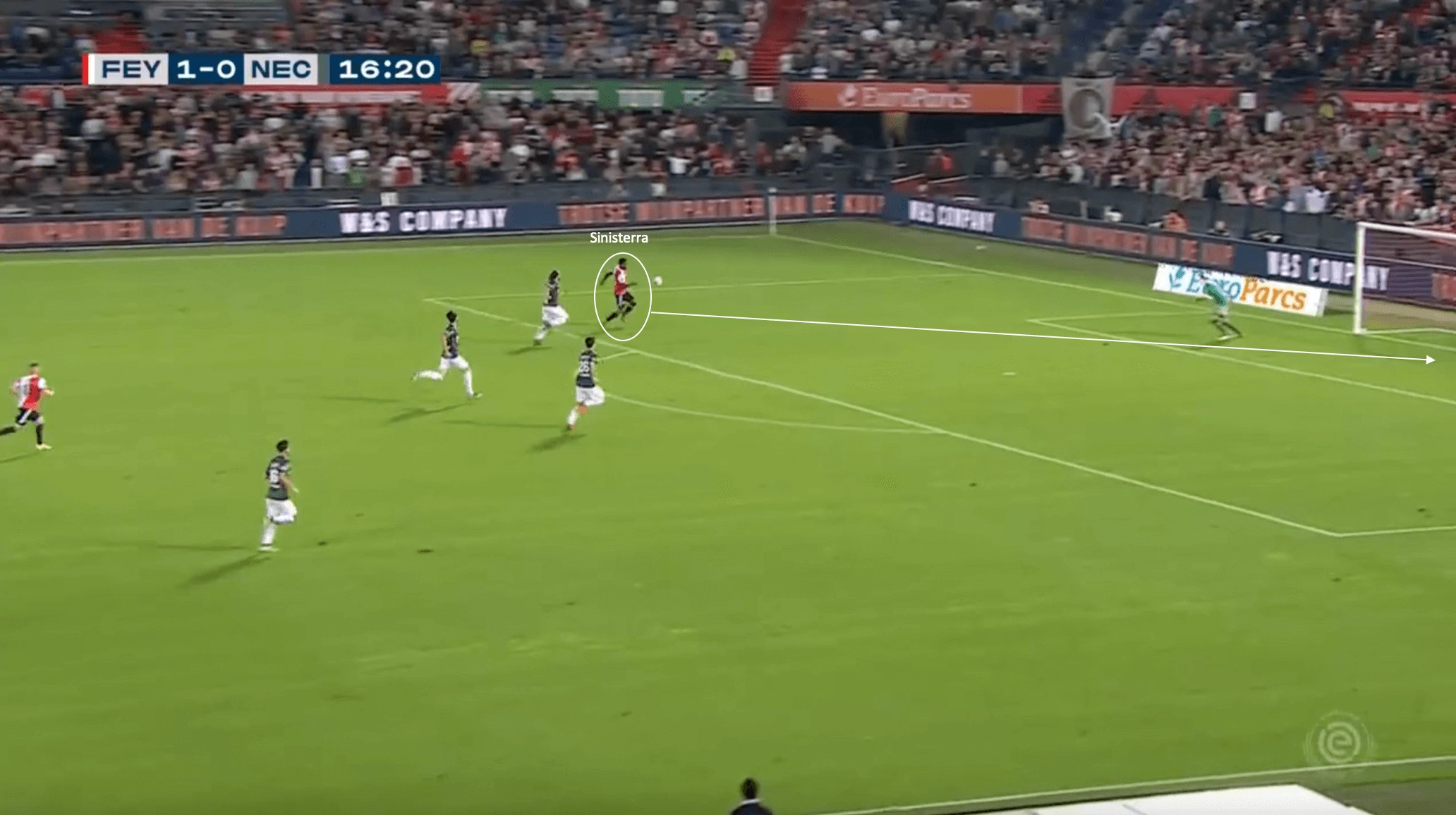
The phase of play above against NEC once again shows the capabilities of Sinisterra’s finishing when not shooting on his favoured right foot. To begin this attacking sequence, Sinisterra makes a great run from just inside the opposition half, which was found by the Feyenoord player in possession. Sinisterra runs onto the ball and drives towards the 18-yard box. With the defender closing him down from behind, Sinisterra does not have time to take a touch and fire a shot on goal with his right foot. As a result, he fires a shot on the bounce with his left foot which goes past the goalkeeper at his far post.
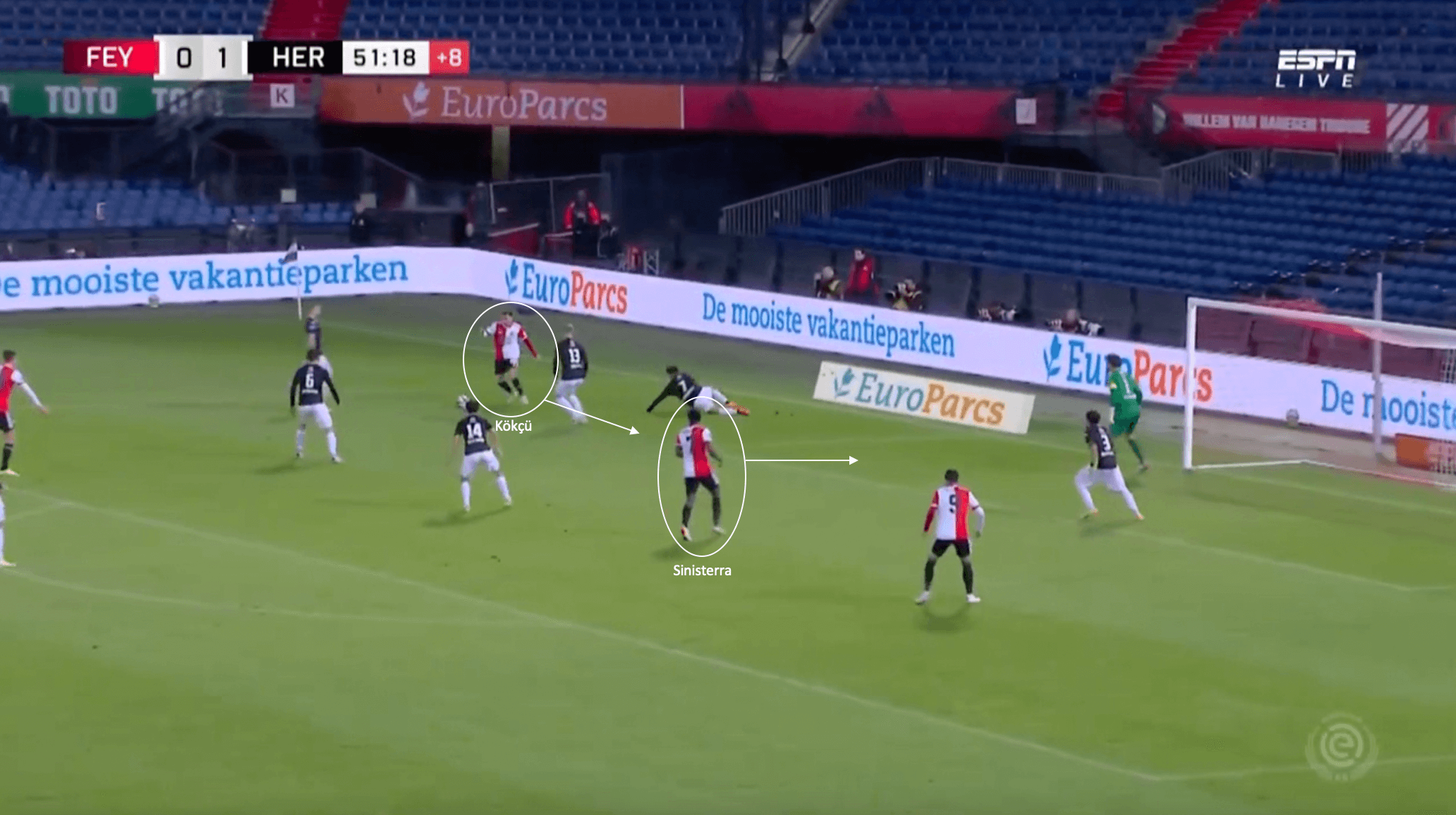
Another characteristic of Sinisterra’s finishing ability is that he does not always score his goals from his usual wide left position. In the attacking phase of play above against Heracles, Sinisterra has drifted into a more central position alongside striker Cyriel Dessers. Sinisterra is able to find a pocket of space, with Orkun Kökçü able to play a pass to him. Sinisterra is able to take one touch and fire past the goalkeeper with his weaker left foot before he gets closed down by the opposition defenders.
This final section has been able to illustrate the finishing ability of Luis Sinisterra; something that has improved year-on-year since his move to Rotterdam. Though he does prefer to ultimately cut inside on his right foot before shooting; Sinisterra also has the capability to shoot also with his left foot and his head. This strength will be able to keep opposition defenders guessing when he ultimately moves to a bigger European league; with them knowing that forcing Sinisterra onto his weaker foot may not be the best idea.
Conclusion
Now into his fourth season with Feyenoord, Luis Sinisterra has begun to come into his own in Rotterdam. Without a doubt, this has been his breakout season, as this analysis has shown. In turn, this has attracted the interest of many big clubs throughout Europe, with the likes of Arsenal, Real Betis, and AC Milan rumoured to be in the hunt for Sinisterra’s signature. Though it is not yet known where Sinisterra will be playing next season, if he can keep this form up through the rest of the Eredivisie and Europa Conference League campaign for Feyenoord, it is looking more and more unlikely that it will be in Rotterdam.


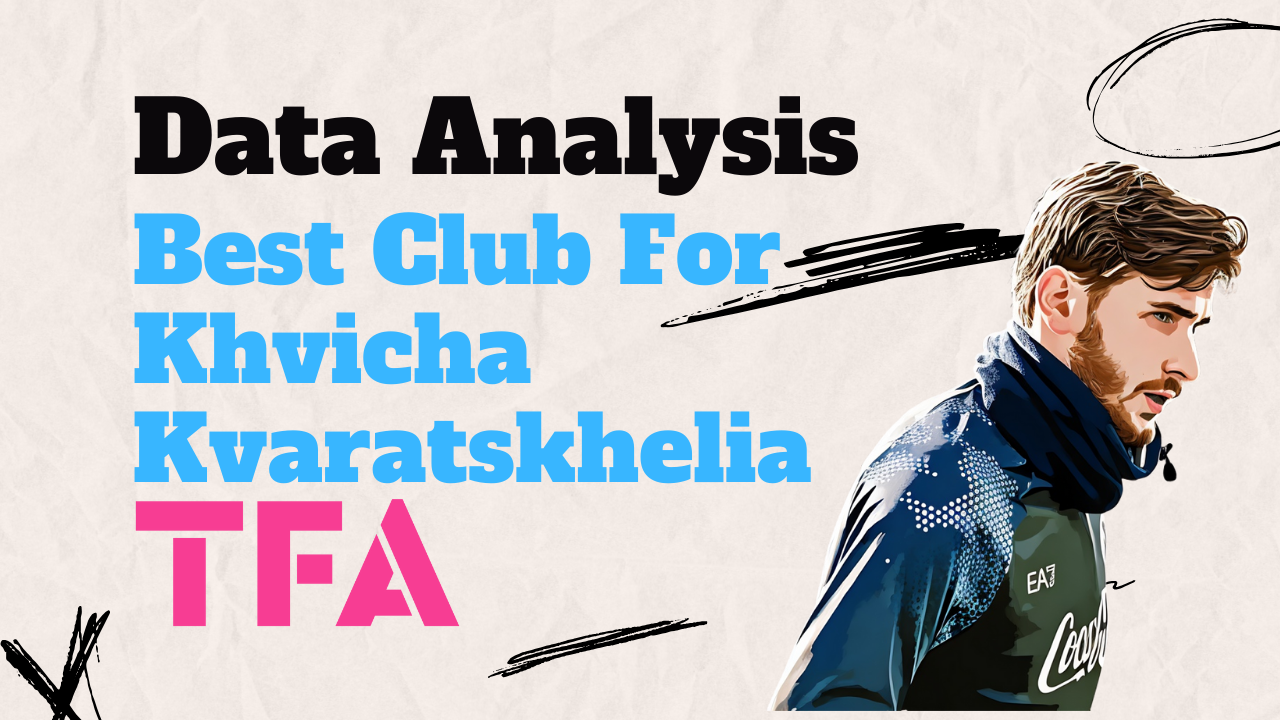
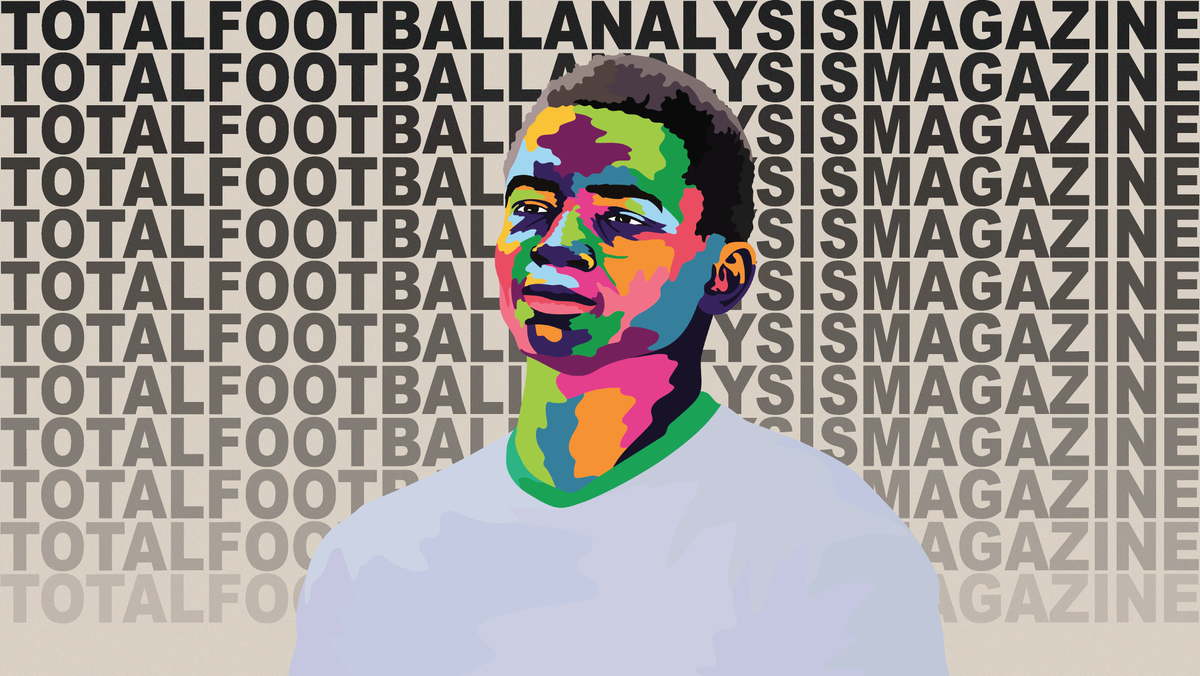

Comments